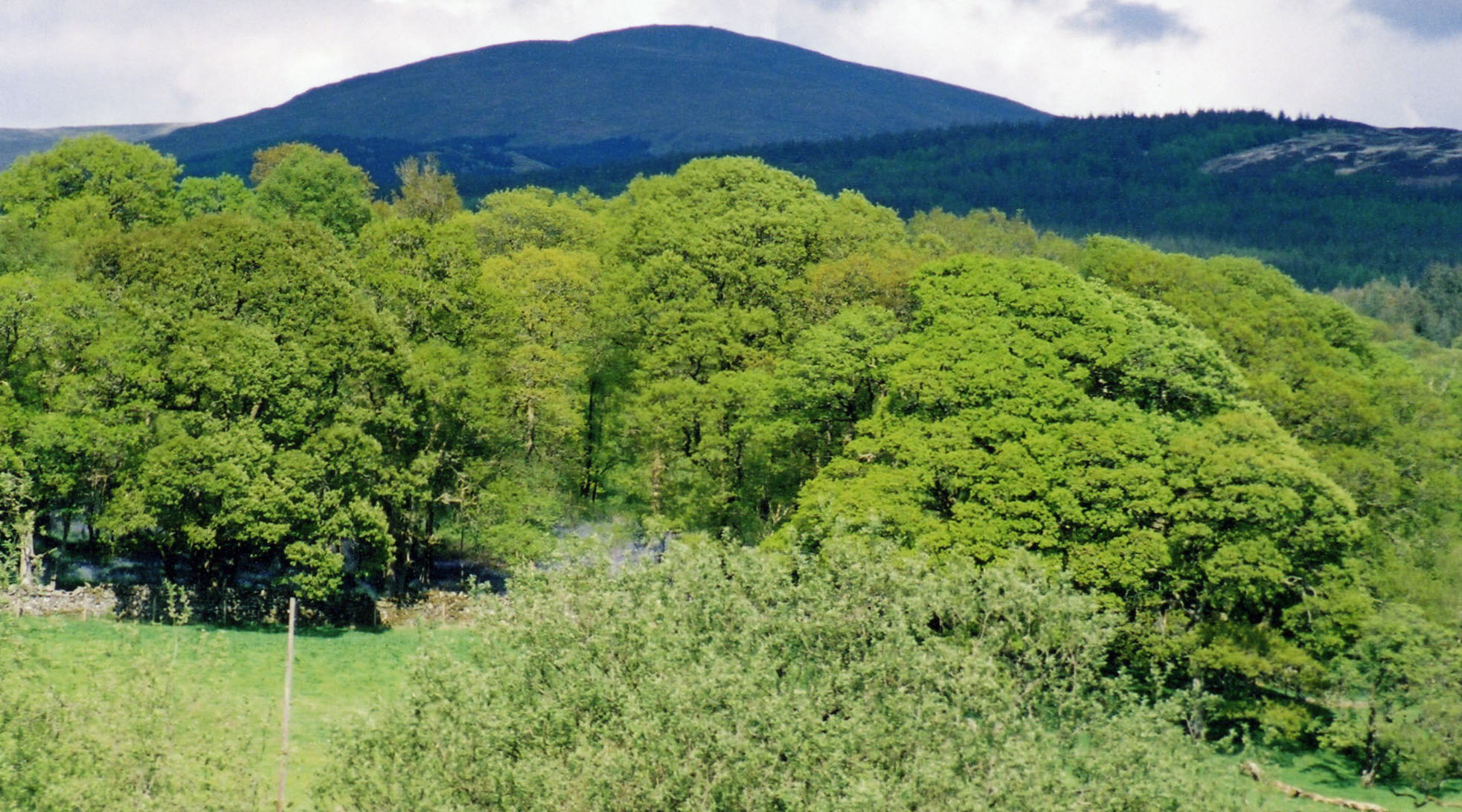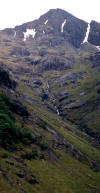|
Lowland Hills
In Scotland, May typically is the driest month of the year. What must Galloway be like after the rains? These photos prove, however, that the lowlands are low only in comparison to the highlands. The hill above caught our eye as we drove east through Galloway; beneath the trees is another patch of bluebells. In the photo on the left, we were standing at Linn's Tomb on Craigmoddie Fell, looking beyond the Southern Upland Way. The scene on the far right was taken from the Way, after leaving Craigmoddie, and displays another view of the ridge in the distance. Bonnie hills such as these are seen throughout the district, and they are bonnier still in September. I wish now we had taken more photos of the Lowland Hills.
The Highlands
The sad thing about the highlands is that overgrazing and logging have robbed most of them of their ancient, native beauty. How we would love to have seen them in wilder days. Sometimes the mountains seem to rise up straight from the lochs. This peak stands on one shore of Loch Linnhe. At the foot of the peak and facing the loch is a home, beyond which the mountain slopes down to the braes. This is a residential setting rarely to be found.
Then there are the Mamore Mountains at Loch Leven, where the water is bluer than the sky. The village of Kinlochleven lies at the foot of the mountains. From there, you can walk to the Grey Mare's Tail, a plume at the end of Britain's highest falls, pictured on the page "Caledonian Waters".
Rannoch Moor On the way to Loch Leven, we passed by Rannoch Moor. Described by Robert Louis Stevenson in his 1886 novel "Kidnapped" as a weary looking desert, it may appear sometimes as a grey-clouded emptiness. It is sometimes, however, a heather-clad wonder. On this day, it was an ethereal scene conjuring up ghosts of kilted warriors and mournful pibrochs. Ben Nevis "I have seen the high Ben Nevis a-tow'ring tae the moon." At 4,406 feet, the highest peak in the Nevis Range is also the highest mountain in all of Great Britain. It is very near to Glen Coe. This series of pictures illustrates the fast-changing skies over Scotland. When the clouds were at their darkest, a light shower began that lasted no more than ten minutes and was gone. Then, as we passed Glen Coe, the sun broke through. Glen Coe means "Glen of Weeping".
Glen Coe
On 14 February 1692, a massacre occurred in Glen Coe that defiled Highland honor and outraged a nation. The MacDonalds and the Campbells had been bitter enemies for two centuries when opportunity for revenge presented itself to the Campbells. Clan chiefs, after their defeat by King William, were offered pardons in exchange for oaths of allegiance. A winter blizzard and other circumstances caused Alasdair, 12th Chief of the MacDonalds of Glen Coe to arrive five days late at the appointed place. He was nonetheless allowed to take the oath. Returning home to Glen Coe, he and his clan believed that all was well. Several weeks later, Captain Robert Campbell came to Glen Coe with two companies of soldiers and asked MacDonald for refuge from a winter storm. Shelter and food were given, and they stayed for ten days. The Highland code of hospitality dictated that Campbell say and do no harm during this time ... yet, while he and his men remained, they were simply awaiting orders. When orders arrived, they rose in the night and set out to kill everyone ~ men, women, and children ~ under the age of 70. About 30 were slain while 300 fled to the hills. Many who escaped the sword died of cold and starvation. The Three Sisters stand as lonely sentinels on the west side of Glen Coe, guarding the graves of MacDonald, his sons, and others. Those who survived the slaughter faded into obscurity. MacDonald of Glen Coe is no more. The Cuillens The Cuillin Hills provided the background for these photos. We admired them only from a distance, which does not reveal the magnificent, rugged terrain that attracts so many climbers. The Black Cuillins, composed of basalt and gabbro, present the most challenging climb in Great Britain. The Red, composed mainly of granite, have weathered into more rounded hills.
Ben Lomond Ben Lomond stands 3,195 feet high on the eastern shore of Loch Lomond. It is the southernmost "munro" in Scotland, a Munro being any mountain over 3,000 feet. Its name means "Beacon Hill", which purpose it served for the clans, such as the MacGregors and the MacDonalds, whose homes lay round about. When need arose, the clans were raised for battle by the lighting of a beacon fire that could be seen for miles. Such was the inspiration for the lighting of the mountaintop beacons in "Lord of the Rings". "Oh, I have seen the highlands, and I have seen the low, And I will sing of this bonnie land wherever I may go." ______________________________________________________________________________________
Copyright 2018 · Loretta Lynn Layman · The House of Lynn
|
||||||||||||||||||||||||||





















